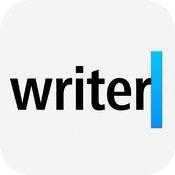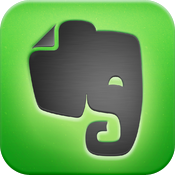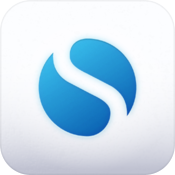iPad Apps For Writers
The iPad's large screen is a fantastic canvas for penning the next great American novel. There are a plethora of apps that can help you type faster, sync over the cloud, and even help you keep up to date on the publishing industry. If you're on the go and inspiration hits, you'll want to have these apps at the ready.

Pages
Apple's dedication to providing their desktop app experience to iOS users comes across no clearer than with Pages. This word processor on steroids leaves out no features while providing an elegant interface. Formatting text is simple with a row of buttons that run along the top of the app. Selected text can be changed via the formatting button and changes reflect instantly. Pages allows you to work with photos, tables, charts, and shapes. It gives you all you need to create the perfect document. Sharing is done through email, printing, iCloud, and exporting out to iTunes. After working in Pages for a minute, you'll completely forget you're on your iPad.

iA Writer
iA Writer takes the traditional word processor and turns your iPad into a text-entry machine. Gone is the standard iOS keyboard, replaced with an extra row of buttons to skip around by word, arrow left and right, and enter special characters. An aperture icon focuses your text to three visible lines to help you focus on the words you're typing in. Syncing of your manuscript is key with iA Writer offering both iCloud and Dropbox support. Sharing options include: email as text, email as attachment, print, and the ability to open the file in other apps.

Evernote
An iPhone favorite from day one, Evernote is the gold standard when it comes to getting things organized with your writing. Aside from the normal text entry fields, Evernote holds key features that make it essential to any iPad. Its search is superb, allowing you to find any note in seconds. It will even search words within photos that are pasted within notes. Full rich text support let you change fonts, add links, and copy data straight from the Internet with the formatting intact. Automatic syncing lets you access your note on another device or the Evernote website. Additional features come through their Evernote Trunk service, giving this app even more power.

Penultimate
If freeform writing is more your style, Penultimate brings that Moleskine feel to your iPad. It’s a simple app that can let you jot down notes using your finger, but if you utilize a stylus the real power of this app shows. Every notebook has infinite pages and you can create infinite notebooks. The pages can be reordered, deleted, or even shared out as a whole book. Standard drawing tools let you use multiple colors and pen sizes to help illustrate anything you need. Penultimate also offers three types of paper. A great feature is the Scissors tool. By drawing a circle around anything on the page, you can move it to another place on the sheet. It’s a fantastic implementation of a powerful Photoshop tool. For handwritten notes, Penultimate is a fantastic choice.

Dragon Dictation
Sometimes you want to sit back, close your eyes, and imagine the story in your head. Why not describe what you’re seeing and get it down into your document? Dragon Dictation does just that, acting as your trusty assistant to take your words and get them down into text. The app is straightforward, taking your words and punctuation and working its magic. Everything spoken is uploaded to their servers and sent back to your device where you can copy and paste it into wherever you need the text to be. When typing isn’t an option, using dictation can easily get your work done.

Dropbox
While it's great to have storage on your iPad, Dropbox has become the defacto service to store your writing in the cloud. Dropbox offers 2 GB of space for free and grows by completing their tutorial, referring friends, or paying for upgrades. By having a Dropbox account you provide a virtual storage locker in the cloud that many apps utilize. The files are accessible everywhere and Dropbox makes backup copies of all files. So, if you delete it by accident, it's recoverable. When it comes to storage, Dropbox cannot be beat.

AP Stylebook 2012
There are a ton of technical words, abbreviations, and phrases that we use each day. If you're going to get them written properly, the AP Stylebook is essential for writers everywhere. As a standard for most publications, the AP Stylebook is the main reference that should live on your iPad. The app opens to a main category list, but a search box at the top is all you need to focus on. Results filter out as you enter a term and with a tap of your finger, you're looking at your desired entry. Each item allows you to append notes and the app keeps a record of all recently viewed items, making it easier to find a term you just used. Every entry can also be starred for a permanent place in the Favorite section. Fast and easy to use, there's no reason you shouldn't have this on your iPad.

Simplenote
An app without the glitz and glam, SimpleNote does what it sets out to do: it creates simple notes. The interface is free of clutter and a full screen mode leaves only your page on your iPad. Every note can be tagged and show past versions. A word count is useful for tracking length while a handy sharing option is built in to make the document a web page. The killer feature of SimpleNote is its syncing. While other apps can sync too, SimpeNote works with the desktop darling of writers everywhere: Scrivener. Scrivener will sync back and forth with SimpleNote, letting you continue your work when you can't be on your computer. This integration is the top reason SimpleNote needs to be on your iPad right now.

Publishers Weekly
You always want to be up on the trends and news going on within the publishing industry. It’s vital in helping you get your writing into the appropriate hands and to learn the current trends. Publishers Weekly has a fantastic iPad app that takes advantage Apple’s automatic delivery of issues that come right into Newsstand, ready to be read. Each page can be zoomed to whichever size you want and the pages are perfect duplicates of the other editions. While the Table of Contents doesn’t look like it contains links, they can all be tapped to flip to the article you want to read. While the app is free, Publishers Weekly uses the iTunes subscription model. A one week subscription costs $7.99 and a one month subscription will run you $19.99. You also gain access to back issues dating to May, 2010.